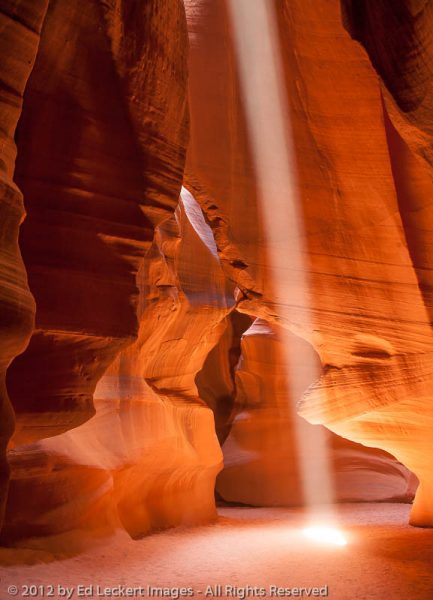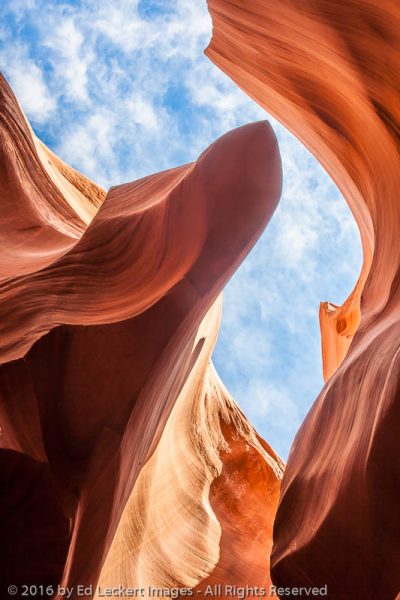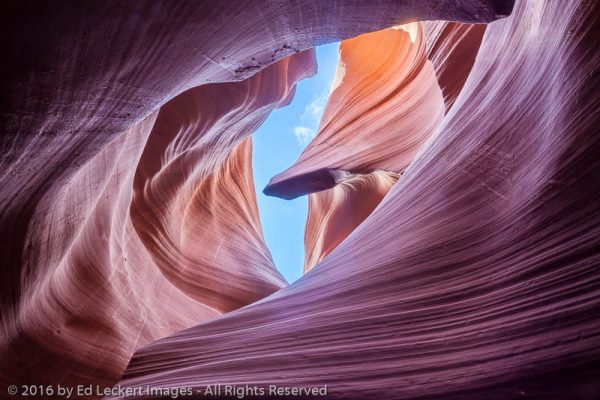


Recently one of my customers asked me if I had more slot canyon images than were showing on my website. It seems he wanted to buy one as a birthday gift. This is exactly the kind of motivation I needed to go back and look through the archives, and as usual, what I found surprised me!
So you’re probably thinking, if I don’t know what images I have in my archives, I must be unorganized. But that’s not the problem at all. My images are carefully keyworded and geotagged as soon as possible after a shoot, and every image is readily accessible through a powerful image database otherwise known as Adobe Photoshop Lightroom. So I know what I have, I just don’t know what I really have.
What I mean by that is that after I come back from a major shoot, such as a multi-week trip to the desert Southwest, I have hundreds of images to sort through. And because of the gear I shoot with and the way I shoot (RAW capture, as much exposure as possible) and the default settings I use in Lightroom, the images don’t always look much like what I saw in the field. They need post-processing to look their best. When you shoot pictures with your smartphone, your phone does this job for you automatically, and phones these days actually do a pretty good job. But I want more control over the process, so I defer this step until I am at home in front of a color-calibrated monitor, and then I do the image “tuning” myself.

A sunbeam finds its way deep onto the canyon floor around midday, in Upper Antelope Canyon near Page, Arizona.
What this all means is that sometimes it’s hard to really see what I have. Looking at a bunch of thumbnail images in their default state requires almost the same process as what Ansel Adams called visualization, or “the ability to anticipate a finished image before making the exposure”. American photographer Minor White called the darkroom version of this process postvisualization, which refers to remembering the visualized image at printing time. The point is, whether in the field or in front of the computer, you need to use your imagination to see the potential of each image, and sometimes on the first pass through, some images get past me. Or sometimes it’s just a lack of time. Whatever the reason, I can always go back to the archives and find hidden gems, at least in my opinion. And that’s what happened when I revisited my slot canyon shoots.
The sunbeam image above is a perfect example. I remember shooting that image, as it took a bit of planning to set up. My friend Jeremy and I specifically booked a photographers’ tour at the right time of year and the right time of day for that phenomenon to occur. The sun has to be very high and at just the right place in the sky for the light to find its way down to the canyon floor. The Navajo guides (required to visit Antelope Canyon) know when this will occur and lead their tours to the spot at the correct time They then clear all of the other tours out of the way so we can get our shots. So obviously I got the shot, but for whatever reason, I never published it.

Surrounded by steep canyon walls, there appears to be no way out, in Lower Antelope Canyon, near Page, Arizona.
What’s even harder to visualize is the images with extreme contrast. Imagine you’re in a dimly lit slot canyon far below the surface, and you look up and see the blue sky peaking through a slit at the top. While even your eyes will have difficulty seeing the beautiful colors in the sandstone where it is in shadow while also looking at the bright sky, your camera’s sensor doesn’t stand a chance of capturing detail in all of these areas, at least with today’s technology. The contrast is simply too great between the light and dark areas to capture it all in one image. However, by shooting multiple images at different exposures, say three images with the aid of a tripod, you can gather enough information to put together a final image with detail in all areas. The problem is that the individual images look terrible! The dark images (exposed for the sky, in this case) are too dark to see, while the light images (exposed for the shadows) have highlights that are completely washed out. And the image(s) in the middle look terrible all over.

The blue sky is visible through a wider section of the canyon, in Lower Antelope Canyon, near Page, Arizona.
This was the case with these last two images. Each one is a combination of three different exposures shot two stops apart each. For the top image, the exposure for the sky was shot at 1/100 of a second at f/16. The middle exposure was shot at 1/25 sec at f/16. (Always change the shutter speed, not the aperture, when doing this, to keep the depth of field constant.) And finally, the exposure for the shadows was shot at 1/6 sec at f/16. For the lower image, the three shots were 1/10 sec, 0.4 sec, and 1.6 sec respectively at f/16. To put them all together, I used the HDR (high dynamic range) feature of Lightroom 6.8.
So there you have it. My customer found what he was looking for, and I found something I wasn’t even looking for, but I’m glad I did!

Wow–Well done!-I love the colors and textures looking up as they escape to the blue sky….beautiful! 🙂
Thanks, Nancy!
That sunbeam pic is incredible! My gob, it has been smacked. :O
The surprise “finds” are some beautiful finished art pieces!
Sunbeam photo is my favorite!
Wow!
Thanks for the great article. Very informative and educational. I’d like to order one more!